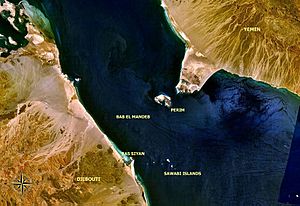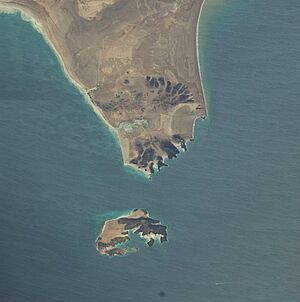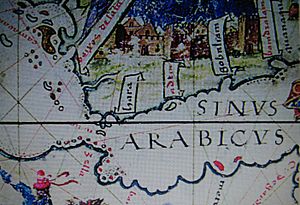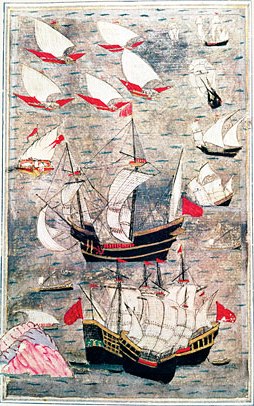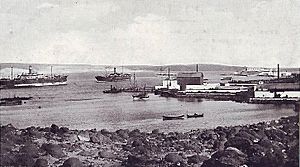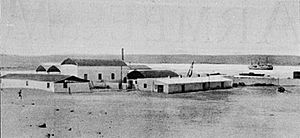Perim facts for kids
Perim (also called Mayyun in Arabic) is a small volcanic island. It sits in the Strait of Mandeb, which is like a narrow doorway at the southern end of the Red Sea. The island is located off the southwest coast of Yemen and belongs to Yemen. It's part of the Dhubab or Bab al-Mandab District in the Taiz Governorate. Perim Island actually splits the Strait of Mandeb into two smaller channels.
For many years, from 1857 to 1967, Perim Island was part of the British Empire. It was considered a dependency of Aden, a major port city nearby.
Contents
What's in a Name?
In ancient times, people called Perim "the island of Diodorus." Writers like Pliny the Elder and Ptolemy mentioned it in their old maps and books.
The name Perim might come from the Arabic word Barim, which means "chain." This name is linked to the history of the strait, which was sometimes seen as a chain across the sea. Another Arabic name for the island is Mayyun.
The Portuguese explorer Afonso de Albuquerque named the island Vera Cruz in 1513. However, this name didn't stick. On many old British and French maps from the 1600s and 1700s, the island was often called Babelmandel, just like the strait itself. By the time the British took permanent control in 1857, the name Perim was commonly used.
Island's Formation
Perim Island is actually a leftover piece of an old volcano. This volcano was active a very long time ago, in the late Miocene period. Its main center was on the southwestern tip of Arabia.
Perim is the westernmost of a line of six volcanoes that stretch about 200 kilometers (125 miles) along the coast of Arabia, all the way to Aden. Scientists believe these volcanoes formed because of a crack in the Earth's crust. This crack spread eastward before the most recent widening of the Gulf of Aden.
Island Geography
Perim Island looks a bit like a crab. It is about 5.63 kilometers (3.5 miles) long and 2.85 kilometers (1.77 miles) wide. The island covers an area of about 13 square kilometers (5 square miles) and its highest point is 65 meters (213 feet) above sea level.
Perim has a deep and large natural harbor on its southwestern side. The small fishing village of Mayyun is located at the bottom of this bay.
Dividing the Strait
The island divides the 32-kilometer (20-mile) wide Bab-el-Mandeb strait into two parts:
- The Large Strait is about 17 kilometers (10.5 miles) wide on average. It's generally deep, with depths of 180 meters (590 feet) or more in the middle.
- The Small Strait is narrower, ranging from 2.5 to 5 kilometers (1.5 to 3 miles) wide. Its depth is between 21.9 and 28.3 meters (72 and 93 feet). Even though it's free from changes in the main shipping lane, strong and unpredictable currents make sailing here tricky. Many ships have been wrecked near Perim, especially in the Small Strait.
Water and Plants
One of the biggest challenges for people living on Perim has always been the lack of fresh water. While it sometimes rains heavily, there can be long periods of eight months or more without any rain. The average rainfall for a long time was only about 60 millimeters (2.4 inches) per year. Because of this, there are very few plants growing on the island.
Island History
The Bab-el-Mandeb strait was likely a path for early humans leaving Africa about 60,000 years ago. At that time, sea levels were much lower because a lot of water was frozen in Ice Age glaciers. This meant the strait was much shallower or even dry.
Despite having a protected natural harbor and being in a very important location at the entrance of the Red Sea, Perim was mostly ignored by written history until the mid-1800s. This was mainly because the bare, dry island couldn't easily support life. So, only fishermen and pearl divers lived there seasonally, building simple huts from materials brought from elsewhere.
In 1513, Afonso de Albuquerque, a Portuguese commander, tried to take control of trade routes to the Red Sea. He attacked Aden but failed. He then sailed into the Red Sea. The Portuguese ships likely used Perim's harbor often during their efforts to control the Red Sea.
Later, the Ottoman Empire took control of Aden in 1538. Their fleet then controlled the Red Sea, the Bab-el-Mandeb, and Aden until the 1630s.
In 1799, the British East India Company briefly occupied Perim. This was part of their preparations for an invasion of Egypt.
Perim Under British Rule
In 1856, British Prime Minister Palmerston decided to occupy Perim. This was to counter French influence, especially with the French-backed Suez Canal project. The British wanted to make sure they had control over this important sea route.
In December 1856, the governor of Bombay ordered the occupation of the island. He said it was already considered part of India's territories since it was taken in 1799. The main reason given for the occupation was the urgent need for a lighthouse. The Bab-el-Mandeb was known for being dangerous for ships. An 11-meter (36-foot) high lighthouse was finally built and opened on April 1, 1861. Even with the lighthouse, the waters around Perim remained risky for ships.
Perim was linked to Aden, which was part of British India. For the next 20 years, the island mostly had the lighthouse and a small group of soldiers. The dry island was left to a few fishermen and Somali herders.
Aden had a good natural harbor, but by the mid-1800s, larger ships couldn't easily use it. Many big steamers had to stay far from Aden Harbour, making it hard to refuel. This problem wasn't fixed until dredging projects started in the early 1890s.
In 1881, a company called the Perim Coal Company (PCC) was allowed to start a coaling station on Perim. Perim's inner harbor could handle very large ships. On August 29, 1883, Perim Harbour supplied coal to its first steamer. This started a competition between Aden and Perim for the Red Sea coaling business, which lasted until the mid-1930s.
For 50 years, Perim was all about supplying coal. The harbor, roads, and worker housing were built just for this purpose. Perim's lack of water wasn't a problem for ships, as both Perim and Aden supplied water from special machines that turned seawater into fresh water. The PCC also became very good at salvaging (rescuing) ships because it was so close to the dangerous waters.
Between 1923 and 1927, Perim loaded more coal than Aden. However, Perim quickly declined because it didn't get involved in the growing oil fuel business. Aden took over that market as ships started using oil instead of coal. The PCC went out of business in 1935, and Perim became less important.
During the First World War, Turkish forces tried to threaten Aden and British shipping in the Red Sea. They attacked Perim on June 14 and 15, 1915. Turkish soldiers landed on the north coast but were pushed back by British Indian soldiers. By the end of the year, the threat to Perim was gone.
In 1964, Perim got a new role. It became the base for the British Middle East Relay Station. This station was built by the British Diplomatic Wireless Service to relay the BBC World Service radio broadcasts. The station had been in Somalia but moved after a disagreement.
The base was built from scratch. Large diesel fuel tanks were put in the port area, and a pipeline was installed to power the generators at the transmitter site. Twenty prefabricated houses were built for engineers and their families. Two small barracks housed soldiers from Aden who provided security. You can still see the foundations of these buildings on Google Earth.
The station started broadcasting in early 1965. It was powerful enough to be heard in Australia and New Zealand in the early morning. A fire broke out in late 1965, damaging a main generator. This prevented enough power for broadcasting. Because of the fire and a worsening security situation in Aden, it was decided to move the transmitters. The Perim station closed, and the transmitters were moved to Masirah Island in Oman before the end of 1966.
British Withdrawal and Aftermath
The British stayed on Perim until 1967. Then, the island became part of the People's Republic of South Yemen. Before leaving, the British government suggested to the United Nations that Perim Island should be made an international zone. This would ensure safe passage for ships in the Bab-el-Mandeb, but the idea was rejected.
Soon after South Yemen became independent in November 1967, it claimed its waters extended 12 miles from its coast. This would include the waters between Perim and the mainland. Despite concerns from other countries, there was no interference with international shipping until 1971. That year, the new Marxist government of South Yemen allowed a group of PFLP fighters to attack an Israel-bound oil tanker from Perim.
During the Yom Kippur War in 1973, South Yemeni artillery on Perim, along with Egyptian naval units, created an unofficial blockade at the southern entrance of the Red Sea. However, after this 1973 blockade, there were no more incidents of interference with international shipping.
South Yemen formed close ties with the Soviet Union. This meant Soviet naval forces could use the former British naval base at Aden, as well as Perim and Socotra islands. This strong Soviet military presence quickly faded after a military coup in South Yemen in 1986 and changes in the Soviet Union.
Perim Island Airbase
Perim Island is very important because of its location in the Bab el-Mandeb strait. This strait is crucial for Saudi oil production, as Saudi Arabia produces a large share of the world's oil. Perim Island is strategically located at the exit of the Red Sea and at the end of the Suez Canal. This important location has led to the recent building of an airbase there.
The UAE and Saudi Arabia are allies of Yemen. However, because of Yemen's civil war, controlling its own land has become difficult. Some accuse the UAE and Saudi Arabia of taking advantage of this. The UAE has been accused of trying to get a 20-year lease for Perim Island. Also, UAE-based tugboats have been reported to be shipping materials to Perim Island to help build the airbase.
2015 Yemen Civil War
After the Houthi takeover in Yemen, the Houthis tried to capture Perim Island. They wanted to control this important trade route across the Bab-el-Mandeb strait. Many of Perim's original inhabitants, about 4,500 people, were forced off the island when the Soviet Union had a military base there.
After the 2015 Yemen civil war began, some of these displaced Perim islanders joined the Saudi-led intervention in Yemen. They wanted to take the island back from the Houthis. The local Yemeni people, with support from the United Arab Emirates Armed Forces, attacked the Houthis. The islanders eventually defeated the Houthis in a fierce battle that lasted a few hours. A power plant on the island was destroyed. The Houthis called the Saudi-led coalition "invaders." The Houthis also planted many mines on the island, which still pose a danger to normal life there.
In March 2021, reports said that in 2016, there was an attempt to build an airbase with a 3,000-meter (10,000-foot) runway in the north of the island. This project was believed to be abandoned in 2017, though some structures and the runway outline were still visible. Satellite images from February 2021 showed that construction had begun on a separate, approximately 1,800-meter (6,000-foot) runway near this project. In May 2021, Yemeni military officials stated that the United Arab Emirates was building the runway. However, later reports, based on a statement from the Saudi state news agency, said the construction was being done by a Saudi-led coalition to secure the area.
Future Bridge Project
In 2008, a huge project was announced for a bridge linking Yemen and Djibouti through Perim Island. This project, called the Bridge of the Horns, was estimated to cost $200 billion. At about 28.5 kilometers (17.7 miles) long, it would be one of the longest bridges in the world.
However, in June 2010, it was announced that the first phase of the project was delayed. This phase involved building a 3.5-kilometer (2.2-mile) long bridge between mainland Yemen and Perim. The delay was until a formal agreement could be signed between Djibouti and Yemen.


